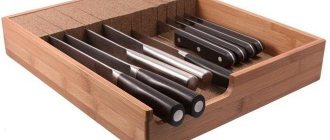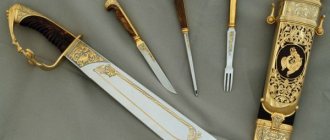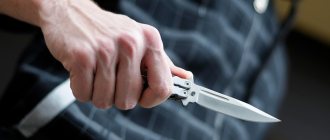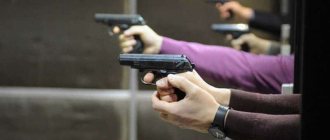Edged weapons are weapons that are used to hit a target using human muscle power through direct contact with the target. Such weapons can be piercing, slashing, piercing-cutting, crushing, and the like. Therefore, edged weapons include Finnish knives, daggers, knives, checkers, sabers, stilettos, brass knuckles, dirks and other objects that are specially adapted or directly intended to hit a living target.
Weapons are not products that are certified as products for industrial or household purposes. These are garden, shoe, kitchen, penknives and the like. You should know that there is responsibility for storing and carrying bladed weapons in 2022. This should be taken into account when purchasing metal products of a piercing or cutting nature. The issue of recognizing a certain object as a cold weapon is decided by forensic examination.
What is considered a bladed weapon?
The Federal Law “On Weapons” provides a definition of this concept. A bladed weapon is an object designed to hit a living target using human muscular strength in contact with the victim of the attack. These are knives, daggers, brass knuckles, sabers.
There are several groups of edged weapons:
- piercing;
- chopping;
- piercing-cutting;
- piercing-cutting;
- impact-crushing;
- throwing;
- combined action: karambit, shuangou.
The following characteristics are characteristic of edged weapons:
You are advised by the best qualified lawyers
Free: Our lawyers provide free initial consultation on any legal issues. 90% of cases are resolved with one free consultation.
24/7: real estate via online chat, or call the hotline 24 hours a day, 7 days a week
- blade length is more than 90 mm;
- blade thicker than 2.4 mm;
- the angle of convergence of the butt and blade is less than 70 degrees;
- blade roll no more than 9 mm;
- minimum steel hardness - 25 Rockwell;
- the blade can penetrate to a depth of more than 20 mm;
- the holder has a finger stop;
- the tip of the blade should be comfortable for striking if the weapon has a stopper.
Only an expert can give an opinion on whether a certain item is a bladed weapon. Experts do not consider weapons that are intended for use in everyday life - garden knives, kitchen knives, manicure scissors.
Classification system
Melee weapons can be classified as one or another type, genus, class, subspecies or species, variety in accordance with various grounds:
- According to the production method.
- Device.
- Operating principle.
- Appointment and so on.
The classification system acts as a scientific and theoretical basis for determining the group affiliation of an object. It is considered one of the most significant structural components of forensic science, which studies not only weapons used in committing crimes, but also all its varieties.
Rules for carrying edged weapons
In Russia, the following categories of persons are allowed to carry edged weapons:
- professional athletes, if it is related to the sport;
- hunters, reindeer herders, rangers;
- law enforcement officers, if they are on duty;
- military personnel can carry not only service weapons, but also award/trophy weapons if they have documents with them;
- forwarding security guards who transport or protect inventory items;
- employees of the Russian Academy of Sciences for certain work and research;
- collectors - professional antique dealers.
Note!
Ordinary citizens can also carry bladed weapons, but to do this they need to obtain a special license.
It is also allowed to buy blades and sabers if they complement the national costume. You can only carry such a weapon during a concert, award ceremony, or national costume parade.
Permit Training
First of all, it is important that a person has a conscious desire to receive this type of modern weapon, and it is also important to understand what kind of responsibility is assigned to him. In addition, you will need to do the following:
- Training required;
- It is important to obtain special permission to purchase weapons;
- A pistol is being purchased;
- Permission to use weapons is obtained.
You can undergo training in special organizations where training courses are organized. They are designed for this purpose and certified for this purpose. After completing the training, you will receive a document confirming completion of qualified training and passing the exam.
License to carry weapons
Permission to purchase and carry weapons is obtained from the licensing department of the Ministry of Internal Affairs at the place of residence. To do this, you need to prepare the following documents:
- statement;
- passport with copies;
- medical certificate that the citizen is allowed to use weapons;
- two 3x4 photographs;
- check for payment of state duty - 350 rubles.
Persons over 18 years of age who have Russian citizenship can obtain a weapons license. A sample application can be obtained from the licensing department of the OLRR or on the State Services website (https://www.gosuslugi.ru/106396/2).
The license validity period is 5 years.
First developments
Various types of bladed weapons were manufactured in the English Special Operations Executive and the American Office of Strategic Services during the Second World War. The products consisted of various items. Knives and daggers were intended to be worn behind the lapels of jackets and jackets; stilettos looked like hat pins. Often, special smaller modifications of leather sheaths were used for knives. Thanks to the special design, the item could be attached to different parts of the body.
Illegal carrying of weapons
The law prohibits carrying bladed weapons unless the owner has a license to do so.
The permit will not be issued if:
- the applicant is under 18 years of age;
- the person does not have a medical certificate allowing him to carry a weapon;
- the person has an outstanding criminal record;
- the citizen was brought to administrative responsibility more than twice a year;
- the applicant does not have a permanent place of residence;
- the citizen received punishment for using or distributing drugs;
- the court prohibited the citizen from keeping any weapons.
Blades for self-defense
In the 70s of the previous century, ordinary citizens were forced to look for means to ensure their safety while on city streets. This was due to a sharp increase in crime. Over the next decade, the volume of manufactured bladed weapons for concealed carry increased significantly. Initially, manufacturers took as a basis the developments of the above USS and USO. Subsequent improvements in the designs of bladed weapons for concealed carry followed the development and implementation of new devices, reducing the size of the blade itself while simultaneously increasing its cutting or piercing properties. Products disguised as ordinary objects were also produced.
Responsibility for carrying bladed weapons
For illegal carrying of weapons, you can incur administrative liability under Article 20.8 of the Code of Administrative Offenses of the Russian Federation. The violator is given a fine of 500 to 2,000 rubles or is deprived of the right to purchase and store weapons for a year.
There will be criminal liability for the sale of bladed weapons. According to Article 222 of the Criminal Code of the Russian Federation, a violator may receive:
- up to 480 hours of compulsory work;
- 1-2 years of correctional labor;
- up to 2 years of forced labor;
- up to 2 years of restriction of freedom;
- 3-6 months of arrest;
- 2 years of imprisonment and a fine of 80,000 rubles or in the amount of the defendant’s income for six months.
What products can I purchase?
A citizen who has a permit to carry and store firearms can also purchase bladed weapons. At the same time, a corresponding mark is made on his ticket. In this case, there is no additional need to obtain a permit to carry bladed weapons. It is used as existing paper. As mentioned above, carrying bladed weapons is allowed with a Cossack uniform or national costume. For this you need the appropriate paper. The document is a license. It gives the right not only to purchase products. The document also acts as a permit to carry bladed weapons as an attribute.
Rules for storing weapons
When purchasing edged weapons, you must provide permission to store them. Without a license, a store employee has no right to sell weapons. In turn, the seller must provide documents for the goods after purchase, so that problems with the law do not arise in the future.
Note!
Since the license is valid for 5 years, upon expiration it must be changed or renewed. The law prohibits the purchase or possession of weapons if the license has expired.
Any weapon at home should be stored in a metal safe. Only the owner should have access to the safe.
It is prohibited to carry bladed weapons for self-defense, as well as during rallies, processions and demonstrations. You cannot send bladed weapons by mail. Athletes may use weapons within the sporting venue. A fencer may only use an epee during training or competition. Military and law enforcement officers are allowed to carry weapons only while on duty.
Types according to existing types
Those edged weapons that have no analogues in the classification system, but at the same time possess all its generic properties and characteristics, are called atypical. Usually this is either a completely original design or a disguised device. The latter include, for example, a stiletto handle and a sword cane. Those edged weapons that correspond to historically established models, are adopted by armies, or are traditional for some nation or nationality are called standard.
Commentary on Article 349 of the Criminal Code of the Russian Federation
Commentary edited by Rarog A.I.
1. The procedure for handling weapons and objects that pose an increased danger to others is determined by the general military regulations of the Armed Forces of the Russian Federation and other regulatory legal acts.
An additional object of the crime is life (parts 2 and 3 of Article 349 of the Criminal Code) and human health, the safety of military property. The subject of the crime is weapons, ammunition, radioactive materials, explosives or other substances and objects that pose an increased danger to others.
2. The objective side of the crime provided for in Part 1 of Art. 349 of the Criminal Code, consists of violating the rules for handling the specified substances and objects, if this entails the consequences specified in the law.
3. The concept of grievous bodily harm is defined in Art. 111 of the Criminal Code. Other grave consequences, in addition to the destruction of military equipment, include damage to important military and civilian facilities, contamination of air, water, large areas of land, mass destruction of fish stocks, animals, etc.
4. The crime is considered completed from the moment of causing serious harm to human health, destruction of military equipment, or the onset of other grave consequences.
5. The subjective side of the crime is characterized by a careless form of guilt in the form of frivolity or negligence.
6. A special subject of a crime is a military serviceman who has violated the rules for handling weapons or objects that pose an increased danger to others.
7. Qualified corpus delicti (Part 2 of Article 349 of the Criminal Code): the same act that negligently resulted in the death of a person.
8. Particularly qualified personnel are contained in Part 3 of Art. 349 of the Criminal Code. A particularly qualifying feature is the infliction of death by negligence on two or more persons.
Special devices
Concealed carry was achieved through belt systems similar to the shoulder straps used for firearms. They made it possible to carry knives of regular (standard) sizes unnoticed by others under outer clothing (jacket or blazer). The production of systems was carried out for a specific model of the product or its specific position (handle down or up, on the back, on the side, and so on). The use of a new type of plastic as a consumable material in the production of covers for knives with a fixed blade or for folding objects was revolutionary. In such a sheath, thanks to its elasticity, the weapon was securely held in any position, as well as quick removal. Manufacturers began to produce sets of knives with carrying systems that made it possible to fix the item in the way the owner preferred.
An example from judicial practice
Let's consider the following clear example of a violation from judicial practice under Art. 349 of the Criminal Code of the Russian Federation.
The Baltic Garrison Military Court, having examined the materials of the criminal case against the defendant Chernykh V.V., found him guilty of committing the crime set out in Part 2 of Art. 349 of the Criminal Code of the Russian Federation.
Chernykh V.V., being a contract soldier, served in the military unit XX and violated the requirements for the safe use of weapons, which through negligence resulted in the death of his colleague FULL NAME82.
The defendant was assigned a daily duty officer at the bottom of the ship, and therefore he was entitled to receive a pistol and 16 rounds of ammunition.
At about 16:55 on the same day, the defendant woke up and, getting ready to form the incoming daily squad, in violation of safety standards, unnecessarily turned off the safety of the pistol he had previously received. He also put a cartridge into the chamber and, believing that it was not there, pointed the pistol at FULL NAME82, who was sleeping on his bed. Then the trigger was pulled and a shot was fired. FULL NAME82 received a gunshot wound to the head.
The defendant Chernykh fully admitted his guilt. At the same time, he testified that he fired the shot accidentally, in a hurry to get into formation, forgetting that he had inserted the magazine into the pistol, without looking where he was pointing the pistol, and in violation of the established and known to him requirements for the safe handling of firearms.
In addition to personal confession, the defendant’s guilt in the crime is confirmed by the totality of evidence examined at the trial.







